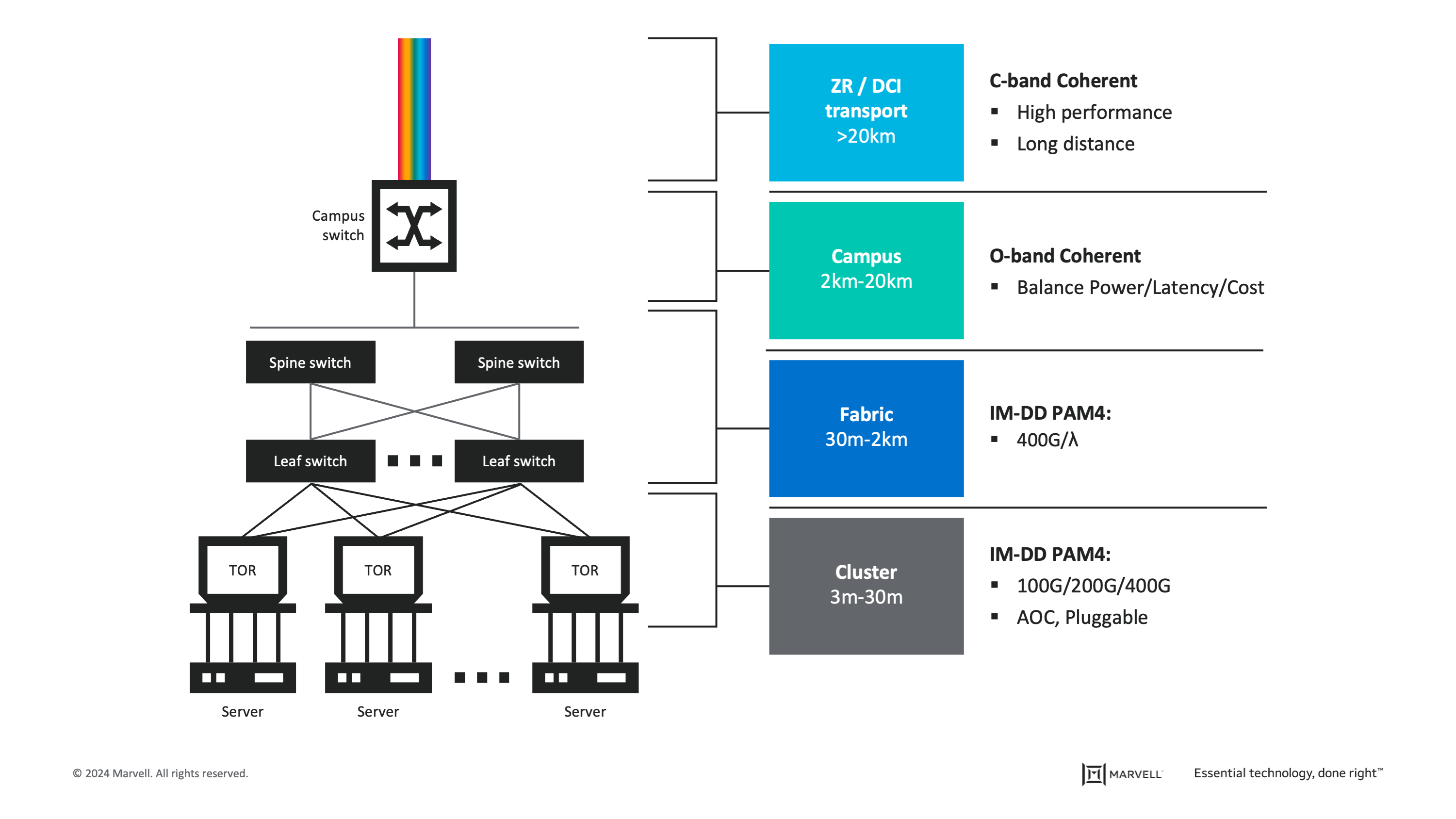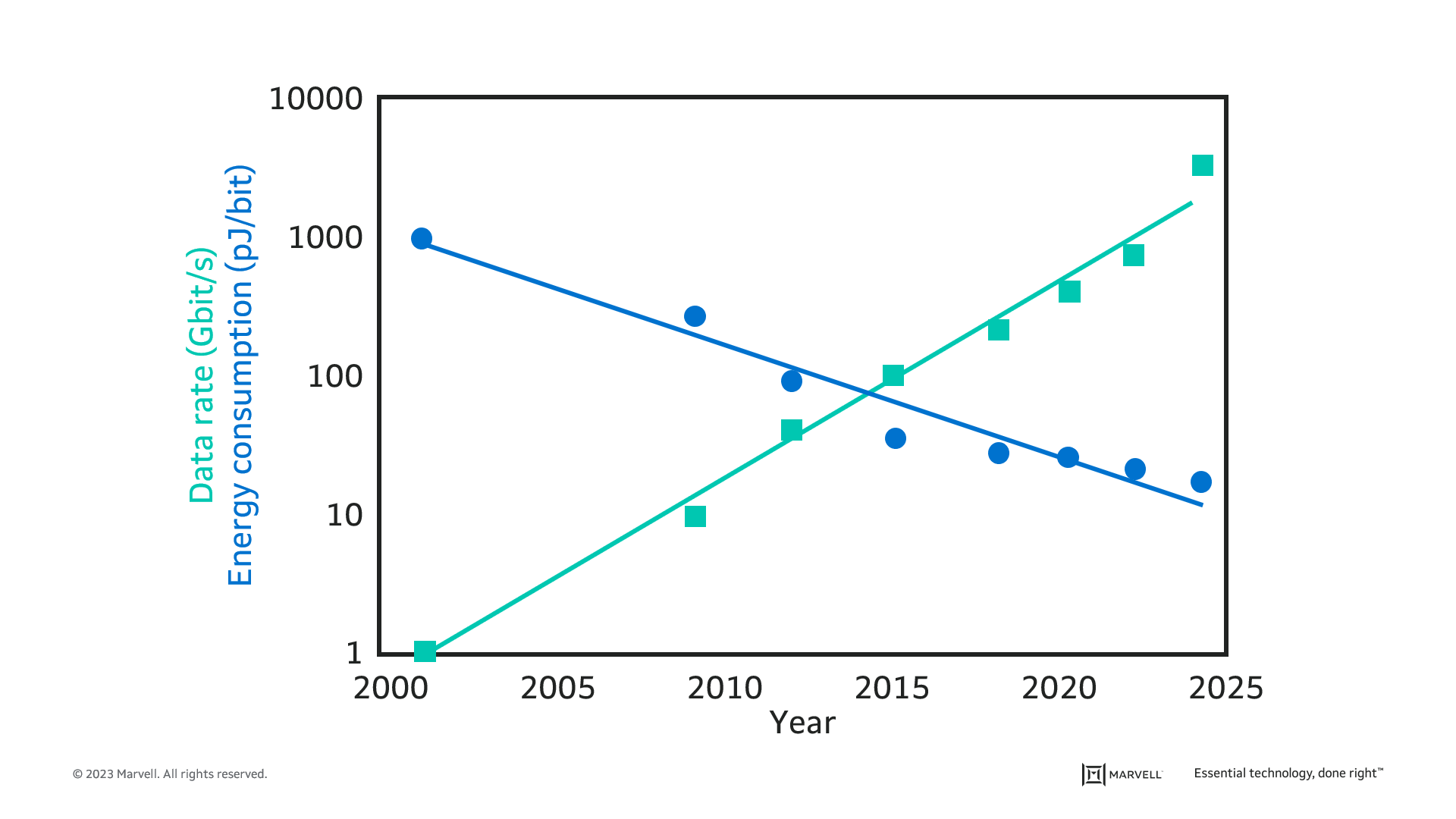Posts Tagged 'Coherent DSP'
-
March 25, 2024
O-Band Coherent: An Idea Whose Time Is (Nearly) Here
By Xi Wang, VP of Product Marketing of Optical Connectivity, Marvell
Over the last 20 years, data rates for optical technology have climbed 1000x while power per bit has declined by 100x, a stunning trajectory that in many ways paved the way for the cloud, mobile Internet and streaming media.
AI represents the next inflection point in bandwidth demand. Servers powered by AI accelerators and GPUs have far greater bandwidth needs than typical cloud servers: seven high-end GPUs alone can max out a switch that ordinarily can handle 500 cloud two-processor servers. Just as important, demand for AI services, and higher-value AI services such as medical imaging or predictive maintenance, will further drive the need for more bandwidth. The AI market alone is expected to reach $407 billion by 2027.
O-band coherent or coherent lite—a technology that has been discussed for years at conferences but has yet to be deployed commercially in a meaningful way--will likely begin to percolate into the market over the next few years to help cloud service providers accommodate some of these challenges.

-
March 19, 2024
光学技术将如何拯救云
作者:Marvell 光学平台高级副总裁兼首席技术官 Radha Nagarajan
This article was first published by Photonics Spectra
The cloud. It evokes an ethereal, weightless environment where problems get whisked away by a breeze.In reality, the cloud consists of massive industrial buildings containing millions of dollars’ worth of equipment spread over thousands, and increasingly millions, of square feet. In Arizona, some communities are complaining that cloud data centers are draining their aquifers and consuming far more water than expected1 while in the UK and Ireland the power requirements of data centers are crimping needed housing development. Even in regions like Northern Virginia where the local economies are tightly bound to data centers, conflicts between residents and the cloud are emerging.
With the rise of AI, these conflicts will escalate. AI models and data sets are growing exponentially in size2 and developers are contemplating clusters with 32,000 GPUs, 2,000 switches, 4,000 servers and 74,000 optical modules3. Such a system might require 45MW of power capacity, or nearly 5x the peak load of the Empire State Building. This resource-intensiveness also shows how AI services could become an economic high wire act for many.

Performance up, Power Down: Over 20 years, the data rate of optical modules has increased by 1000x while power per bit has decreased by 100x.
-
February 22, 2024
Marvell High-Speed Optical Connectivity Solutions Achieve 2024 Lightwave Innovation Honors
By Kristin Hehir, Senior Manager, PR and Marketing, Marvell

Marvell is excited to announce that three of its high-speed optical connectivity solutions have been distinguished among the best in the industry by the 2024 Lightwave Innovation Reviews. The three awards validate Marvell leadership in PAM4 DSP, coherent DSP and data center interconnect (DCI) modules for accelerated infrastructure.
A panel of judges, comprised of experts from the optical communications community, awarded Marvell with the highest score possible of 5.0 for both its Nova 1.6 Tbps PAM4 electro-optics platform and COLORZ® 800 ZR/ZR+ pluggable module, and an outstanding 4.5 honoree status for its Orion 800 Gbps coherent DSP. The honors reflect the industry’s recognition of Marvell leading-edge technologies to address the growing bandwidth and connectivity needs of artificial intelligence (AI), cloud data center and carrier networks.
Lightwave Editor In Chief Sean Buckley expressed his congratulations, stating, “On behalf of the Lightwave Innovation Reviews, I would like to congratulate Marvell on achieving a well-deserved level honoree status. This competitive program enables Lightwave to showcase and applaud the most innovative products, projects, technologies, and programs that significantly impact the industry.”
-
October 19, 2023
走近 AI 时代下的 Marvell 光学技术与创新
By Kristin Hehir, Senior Manager, PR and Marketing, Marvell
The sheer volume of data traffic moving across networks daily is mind-boggling almost any way you look at it. During the past decade, global internet traffic grew by approximately 20x, according to the International Energy Agency. One contributing factor to this growth is the popularity of mobile devices and applications: Smartphone users spend an average of 5 hours a day, or nearly 1/3 of their time awake, on their devices, up from three hours just a few years ago. The result is incredible amounts of data in the cloud that need to be processed and moved. Around 70% of data traffic is east-west traffic, or the data traffic inside data centers. Generative AI, and the exponential growth in the size of data sets needed to feed AI, will invariably continue to push the curb upward.
Yet, for more than a decade, total power consumption has stayed relatively flat thanks to innovations in storage, processing, networking and optical technology for data infrastructure. The debut of PAM4 digital signal processors (DSPs) for accelerating traffic inside data centers and coherent DSPs for pluggable modules have played a large, but often quiet, role in paving the way for growth while reducing cost and power per bit.
Marvell at ECOC 2023
At Marvell, we’ve been gratified to see these technologies get more attention. At the recent European Conference on Optical Communication, Dr. Loi Nguyen, EVP and GM of Optical at Marvell, talked with Lightwave editor in chief, Sean Buckley, on how Marvell 800 Gbps and 1.6 Tbps technologies will enable AI to scale.
-
September 05, 2023
800G: 光网络的一个拐点
By Samuel Liu, Senior Director, Product Line Management, Marvell
Digital technology has what you could call a real estate problem. Hyperscale data centers now regularly exceed 100,000 square feet in size. Cloud service providers plan to build 50 to 100 edge data centers a year and distributed applications like ChatGPT are further fueling a growth of data traffic between facilities. Similarly, this explosive surge in traffic also means telecommunications carriers need to upgrade their wired and wireless networks, a complex and costly undertaking that will involve new equipment deployment in cities all over the world.
Weaving all of these geographically dispersed facilities into a fast, efficient, scalable and economical infrastructure is now one of the dominant issues for our industry.
Pluggable modules based on coherent digital signal processors (CDSPs) debuted in the last decade to replace transponders and other equipment used to generate DWDM compatible optical signals. These initial modular products didn’t offer the same performance as the incumbent solutions, and could only be deployed in limited use cases. These early modules, with their large form factors, had performance limitations and did not support the required high-density data transmission. Over time, advances in technology optimized the performance of pluggable modules, and CDSP speeds grew from 100 to 200 and 400 Gbps. Continued innovation, and the development of an open ecosystem, helped expand the potential applications.
最近推文
- Infosec Global and Marvell partner to provide Crypto Agility in the Cloud
- HashiCorp and Marvell: Teaming Up for Multi-Cloud Security Management
- Cryptomathic and Marvell: Enhancing Crypto Agility for the Cloud
- The Big, Hidden Problem with Encryption and How to Solve It
- Self-Destructing Encryption Keys and Static and Dynamic Entropy in One Chip

